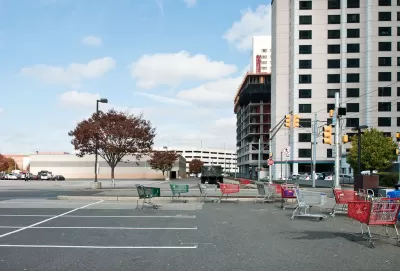In Minneapolis, and cities across the country, surface parking lots are an enduring blight on urban landscapes; their presence often incentivized by existing tax structures. Could a new approach to property taxation maximize the productivity of land?

Chris Keimig looks at the ways in which the conventional property tax system is sabotaging Minneapolis's development goals by disincentivizing more productive use of the city's overabundance of surface parking lots; a blight that covers one-third of the entire surface area of downtown. "The conventional property tax, which taxes land and buildings at the same rate, is essentially backwards when it comes to the behaviors it incentivizes," argues Keimig. "It penalizes property owners for building or making improvements to their structures, while rewarding speculators and absentee landlords who would rather allow their properties to decay than make expensive (and annually taxable) improvements."
To solve this dilemma, Keimig advocates a two-rate system that would tax land at a higher rate than buildings. "By taxing land at or near its development potential," he says, "owners of land being used at less than maximum productivity would be paying a disproportionate amount in taxes in order to keep it that way."
"Aside from the obvious goal of raising money to pay for public services, we levy taxes either to discourage a particular behavior in favor of another (taxes on cigarettes and alcohol discourage consumption and thus promote healthier lifestyles/lower health care costs), or because a given resource is scarce while demand for it is high (i.e., the gasoline tax). But if the city is trying to encourage development—and to attract the 70,000 more downtown residents it seeks by 2025—it hardly makes sense to place a tax on that behavior. Similarly, if the city wants potential developers to treat land as the scarce resource that it is—encouraging them to build up rather than out in order to maximize economic output and reduce sprawl—it makes sense to tax land at a higher rate than buildings."
FULL STORY: Tax Land, Not Buildings

Alabama: Trump Terminates Settlements for Black Communities Harmed By Raw Sewage
Trump deemed the landmark civil rights agreement “illegal DEI and environmental justice policy.”

Planetizen Federal Action Tracker
A weekly monitor of how Trump’s orders and actions are impacting planners and planning in America.

The 120 Year Old Tiny Home Villages That Sheltered San Francisco’s Earthquake Refugees
More than a century ago, San Francisco mobilized to house thousands of residents displaced by the 1906 earthquake. Could their strategy offer a model for the present?

In Both Crashes and Crime, Public Transportation is Far Safer than Driving
Contrary to popular assumptions, public transportation has far lower crash and crime rates than automobile travel. For safer communities, improve and encourage transit travel.

Report: Zoning Reforms Should Complement Nashville’s Ambitious Transit Plan
Without reform, restrictive zoning codes will limit the impact of the city’s planned transit expansion and could exclude some of the residents who depend on transit the most.

Judge Orders Release of Frozen IRA, IIJA Funding
The decision is a victory for environmental groups who charged that freezing funds for critical infrastructure and disaster response programs caused “real and irreparable harm” to communities.
Urban Design for Planners 1: Software Tools
This six-course series explores essential urban design concepts using open source software and equips planners with the tools they need to participate fully in the urban design process.
Planning for Universal Design
Learn the tools for implementing Universal Design in planning regulations.
Clanton & Associates, Inc.
Jessamine County Fiscal Court
Institute for Housing and Urban Development Studies (IHS)
City of Grandview
Harvard GSD Executive Education
Toledo-Lucas County Plan Commissions
Salt Lake City
NYU Wagner Graduate School of Public Service




























